Menus
- Single-cylinder enduro bikes in a comparison test
- Single-cylinder enduro bikes in a comparison test
- MOTORCYCLE conclusion
- Technical specifications
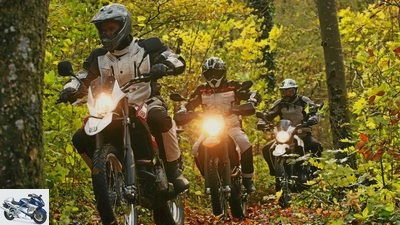
Jahn
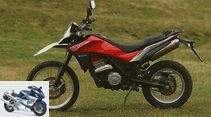
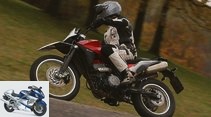

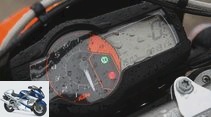
22nd photos
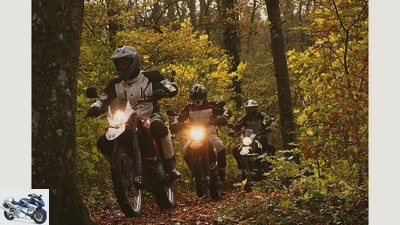
Jahn
1/22
Husqvarna TR 650 Terra, KTM 690 Enduro R and Yamaha XT 660 R in the enduro everyday comparison test.
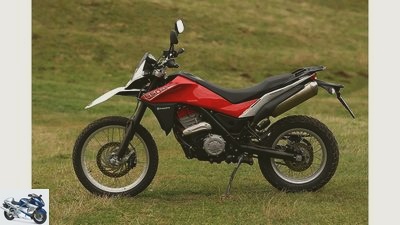
Jahn
2/22
Husqvarna TR 650 Terra.
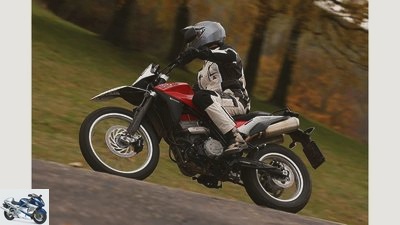
Jahn
3/22
Husqvarna TR 650 Terra – probably the best compromise between road and off-road suitability.
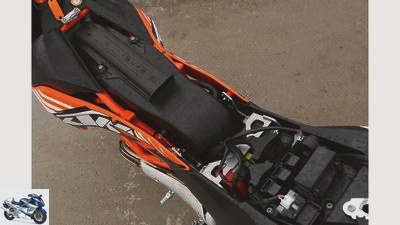
Jahn
4/22
KTM 690 Enduro R: A huge air filter is located where the tank is otherwise. The fuel supply of twelve liters is bunkered in the self-supporting frame rear – and this is what makes the low weight possible.
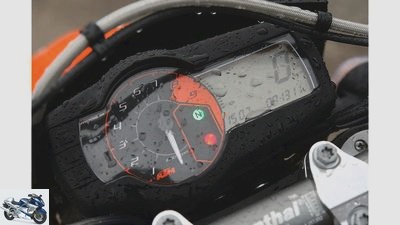
Jahn
5/22
KTM 690 Enduro R: digital cockpit with classic tachometer.
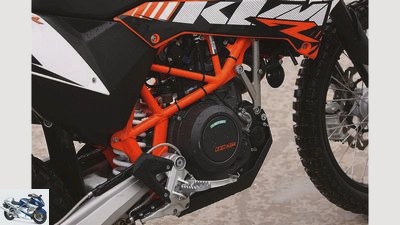
Jahn
6/22
KTM 690 Enduro R: tubular space with a strong 690.
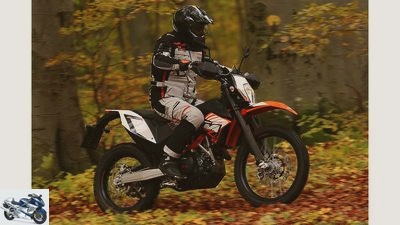
Jahn
7/22
KTM 690 Enduro R – This is what Enduro looks like.
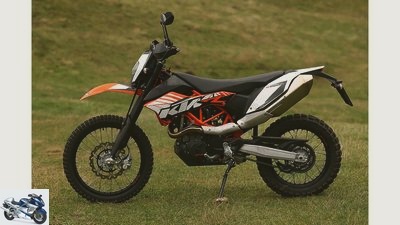
Jahn
8/22
The competitive KTM 690 Enduro R.
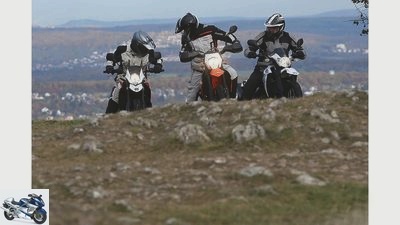
Jahn
9/22
“Well, is there anything else?” Offroad, the tire is the main factor that determines propulsion.
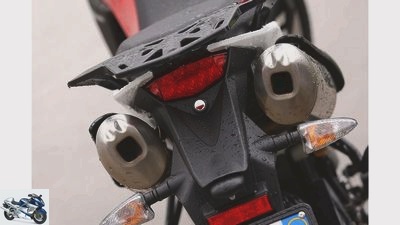
Jahn
10/22
Husqvarna TR 650 Terra: The rear with two rear silencers.
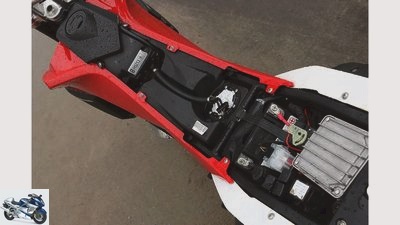
Jahn
11/22
Husqvarna TR 650 Terra: The tank is pulled far under the seat.
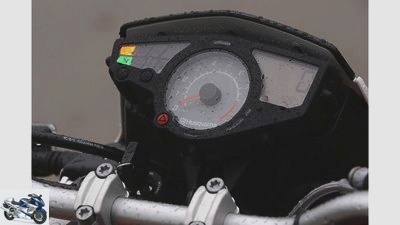
Jahn
12/22
Husqvarna TR 650 Terra: The cockpit with analog tachometer is complete.
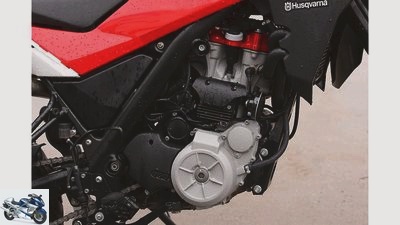
Jahn
13/22
Husqvarna TR 650 Terra: The engine comes from the G 650 GS and looks like it. A Husky valve cover must be red, however, and the output must be higher. An engine protection is completely missing. After all, the elbow is not in the way.
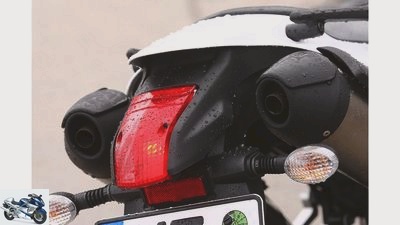
Jahn
14/22
Yamaha XT 660 R: The rear and the two rear silencers.
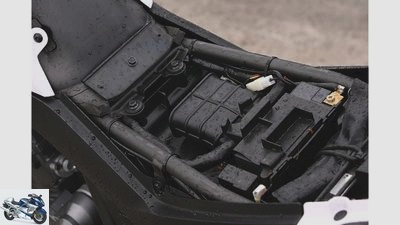
Jahn
15/22
Yamaha XT 660 R: The air filter is still in the frame triangle and the tank is between the legs.

Jahn
16/22
Yamaha XT 660 R: A concession to the modern: digital cockpit, but without a rev counter.
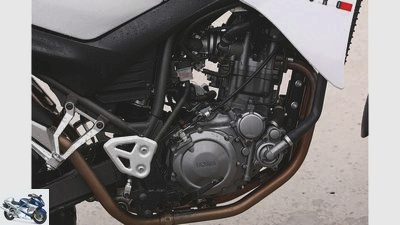
Jahn
17/22
Yamaha XT 660 R: manifold and engine without protection from impacts. Usually you won’t need it either.
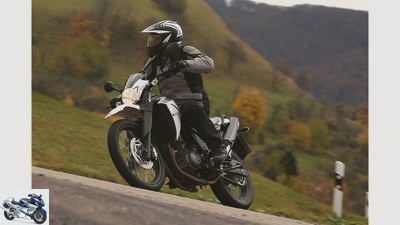
Jahn
18/22
Not radical, but conventional – the design of the XT 660 R.
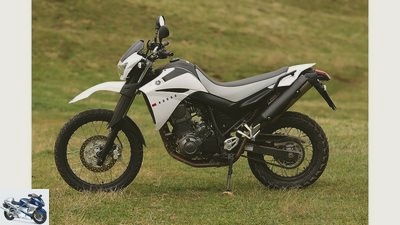
Jahn
19/22
The Yamaha XT 660 R.
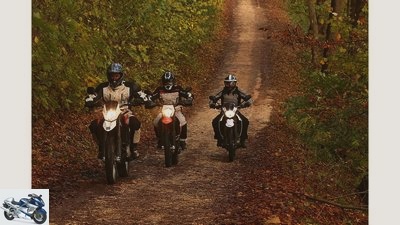
Jahn
20/22
Husqvarna TR 650 Terra, KTM 690 Enduro R and Yamaha XT 660 R.
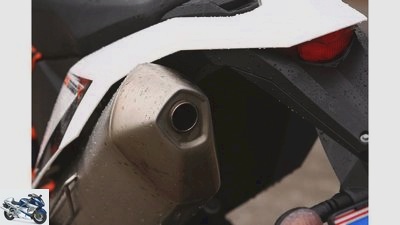
Jahn
21/22
The mono silencer instead of two bags from the competition.
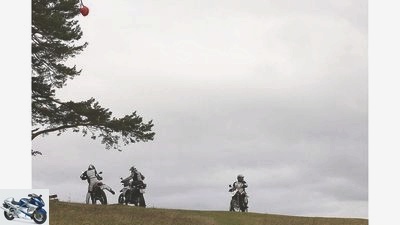
Jahn
22/22
Still life: autumn on the Swabian Alb. The engines are silent.
Husqvarna TR 650 Terra, KTM 690 Enduro R and Yamaha XT 660 R in the test
Single-cylinder enduro bikes in a comparison test
With the new TR 650 Terra, Husqvarna joins the circle of knights of the tunnel who also have to cope with everyday life. Does this work? KTM 690 Enduro R and Yamaha XT 660 R help to clarify this in a comparison test.
Single-cylinder enduro bikes in a comparison test
E.There are days when well-being depends on the choice of transport. Days like this. Autumn is irrevocably here, wet leaves are on the streets, temperatures in the single-digit plus range, deep gray soup over the mountain ranges of the Swabian Alb, clogged main traffic arteries in the Stuttgart basin. It is best to stay at home on days like this. Or, if need be, takes the tram. In the worst case scenario, a car. But never a motorcycle.
Buy complete article
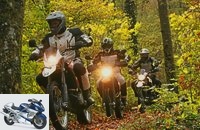
Husqvarna TR 650 Terra, KTM 690 Enduro R and Yamaha XT 660 R in the test
Single-cylinder enduro bikes in a comparison test
TR 650 Terra with the significantly revised and strengthened BMW single-cylinder engine of the G 650 GS. The KTM 690 Enduro R, which now has the Duke’s large 690 engine (but without its ride-by-wire and double ignition) and also has to replace the standard version. And the forefather of all undemanding everyday enduros, the Yamaha XT 660 R, with beginner-friendly 48 hp (optional with the Husqvarna) and basically without any serious off-road attitude.
Jahn
Husqvarna TR 650 Terra, KTM 690 Enduro R and Yamaha XT 660 R.
But: how much of it do you need on a day like this? Or the other way around: How much Enduro can such a trip take? One thing is clear: With its uncompromising off-road approach, the KTM is miles ahead of the other two when it comes to serious enduro inserts. Would you like some examples? The weight of the Enduro R with a full tank of 152 kilograms is light years below that of the competition, whose almost 190 kilograms regularly push them out of the lane on loose terrain. Or the engine: With its displacement advantage of 30 or 40 cubic centimeters, the thoroughbred enduro from Mattighofen draws a nominal performance increase of 8 (Husqvarna) or 19 HP (Yamaha) with its 67 hp. A head start that is also largely manifested on the MOTORCYCLE test bench and allows the KTM and Yamaha in particular to compete in different performance leagues, while the Husqvarna with its revving single is not in the middle, but between the two.
Tires and suspension travel also differ: Contis TKC 80 on the KTM is the off-road legend among road-legal tires that has turned into studs, while the Metzeler Tourance on the Yamaha drives its travel ambitions in the name. And again the Husky with the well-known Metzeler Enduro Sahara 3 places itself between the two, wants to meet road and terrain demands. And then, with a modest 190 millimeters of spring travel at the front and rear, it would rather go through the asphalt jungle than through the Swabian undergrowth, while in this respect even the XT (225/200 mm) and especially the KTM (250 millimeters front and rear) strive for heaven more clearly. With consequences for the seat height. 930 millimeters – the legs shouldn’t be much shorter if you want to ride Enduro R..
In the city center, this means nothing less than a box seat on the narrow, hard seat upholstery, from which the best overview and impeccable maneuverability are guaranteed. So the advantage of KTM? Not necessarily, because first of all, one floor seven centimeters lower on the Husky and the XT still have excellent foresight. And secondly, it is already apparent here what is manifested beyond the place-name signs. The Dunlop TKC 80 on the KTM is simply not a tire for asphalt operation.
Jahn
“Well, is there anything else?” Offroad, the tire is the main factor that determines propulsion.
It’s not even about the rustic comfort of the coarse truck, but about the fact that it simply brings too little rubber onto the road, especially from tight corners, to counteract the powerful torque volleys of the power single with the appropriate interlocking. If you only look at the performance curves on the crankshaft and think that this is all half as wild, the short secondary gear ratio of the Enduro R is not in view. The mighty hump of torque that the Austria stew builds up from 5000 rpm, reaches the rear wheel at 80 km / h in the last gear. And earlier in the smaller corridors.
On the expressway out into the autumn forest, the result is an entertaining, but also quite unstable melange, especially at higher speeds. Mainly because the straight line from 130 km / h on the KTM becomes a real egg dance, while the Husky (with clear cutbacks because it too is noticeably getting out of hand) and the Yamaha (unrestricted) also go beyond the Motorway Recommended Speed Feel at home.
In any case, as far as is possible for single-cylinder enduro bikes of this type. So get off the expressway, up to the Alb. And with that into the terrain for which the Husqvarna in particular seems to be made. ABS (can be switched off), easy-revving motor, spring travel not too long, restrained, sporty seating position – that actually results in a mixture that is convincing. Weasel-agile and neutral, the Husky sticks from one corner to the other, is more manageable than the XT and the KTM, which its tires again stand in the way in this respect. Above all, however, the strengthened BMW single is convincing, which the extensive work on the cylinder head and a significantly increased compression brought a whopping 11 hp more. With the result that it really gets going where the Yamaha single has already reached the peak of its creative power (namely beyond 5000 rpm), and then reaches exactly its rated output of 59 hp at 7300 rpm.
That is a whopping 10 hp more than the Yamaha delivers on the test bench. And yet that’s not a big deal for the aged XT engine with noticeably more flywheel mass, because it has something that the other two lack. It is this agricultural machinery character, this robust punch at low revs, that fits perfectly with the rustic nature of the XT – and with this venture. If you are never in a particular hurry, like to drive in high gear and stop here and there to listen to the birds, the XT 660 R is ideal for you – and shouldn’t waste any thought on the KTM. Because their single is completely different. Aggressive, demanding, of exuberant temperament. Just how he hangs on the gas and turns up in a flash is in a class of its own. In addition, over the years the Austrians have managed to cultivate this competitive athlete to such an extent that in the speed range below 3000 rpm it no longer whips listlessly on the chain, but at least joins it. In return, the willingness to perform increases so vigorously beyond 4000 rpm that the lightweight 690 Enduro R from this brand upwards can easily be placed on the rear wheel even in second gear if necessary. A real show, especially since the KTM’s 690 engine helps achieve by far the best acceleration and pulling power in this field. And yet it is certainly not for everyone. Neither does the razor-sharp brake of the KTM, which delights the expert and can certainly frighten the layman. In any case, the much more defensive single-disc systems of the TR 650 Terra and XT are sufficient for motorcycle hiking, while one could certainly imagine a bit more bite with both of them.
Jahn
Still life: autumn on the Swabian Alb. The engines are silent.
Things look a little different with the chassis design. The KTM, which is almost 2000 euros more expensive, is in a league of its own here too, and with the powerful, fully adjustable 48 mm upside-down fork and the fully adjustable WP shock absorber, it has real professional equipment. Alone: Anyone who is not ambitious in difficult terrain, but on a relaxed country trip, as here, will also make peace with the less fully damped spring elements of the other two, especially since the ride comfort in the forest and meadow is even higher than on the Spartan KTM- High seat. However, the situation changes immediately as soon as the trio leaves solid ground and turns onto dirt roads or even into the forest. Now the Enduro R is finally coming – and with it the coarse TKC 80 as well, while the other two struggle with very individual minor mishaps.
The biggest mishap of the XT 660 R is undoubtedly the Metzeler Tourance with its large tread blocks, an almost flawless road tire that is already pushed to its limits by a wet meadow or a serious incline. The Enduro 3 Sahara the Husky does a lot better, even if its name is designed for completely different realms. The Terra follows the 690s on the hike through forests and fields, only to lose touch when the ground is really deep or the terrain becomes heavier. Or when there are narrower, trial-like sections, because the overall successful engine set-up of the TR engine is unsatisfactory in one respect. As in city traffic, the Husqvarna single running out of push mode at low engine speeds often runs the risk of dying suddenly. And sometimes it does, which requires a quick reaction from the driver. The KTM, on the other hand, bravely plays along, despite its more radical design, even in low engine speed regions and is at its best when the terrain becomes more extensive and the distortions more severe. Then, in addition to the tire, it weighs in above all its low weight, but also its ergonomic proportions and continues to dig with relish where the XT has been standing for a long time and the Terra can only follow with great difficulty. It is and will remain a real adventure bike, despite the recent moderation – after all, its predecessor with the smaller 654 engine had suspension travel 25 millimeters longer – it is an enduro made from real shot and grain. Husqvarna, on the other hand, is aiming in a different direction with the Terra, appealing more to the everyday driver. And ends up roughly where the XT 660 R has already arrived.
MOTORCYCLE conclusion
Jahn
Husqvarna TR 650 Terra – probably the best compromise between road and off-road suitability.
For days like this…
…there is probably not the perfect motorcycle, but the best compromise. And it’s called Husqvarna TR 650 Terra. The new Husky fits between the two extremes, but with a clear tendency towards more roadworthiness. And with 59 hp, decent equipment and standard ABS, it offers a lot of enduro for the money.
At least if you compare it with the Yamaha XT 660 R, which has 11 hp less and no ABS for the same price. In return, the XT not only delivers a decent country road performance and stable straight-line stability, but also the typical robust punch of a single-cylinder engine that the synthetically potty Terra cannot offer.
The KTM, on the other hand, is in a class of its own. Much closer to enduros like the in-house EXC models than to an everyday enduro like the XT and takes some getting used to because of the tires on the road, but entertaining.
Technical specifications
Jahn
Husqvarna TR 650 Terra, KTM 690 Enduro R and Yamaha XT 660 R.
| Husqvarna | KTM | Yamaha | engine |
| design type | Single cylinder four-stroke engine | Single cylinder four-stroke engine | Single cylinder four-stroke engine | injection | Ø 43 mm | Ø 46 mm | Ø 44 mm |
| coupling | Multi-disc oil bath clutch | Multi-disc oil bath clutch (anti-hopping) | Multi-disc oil bath clutch | Bore x stroke | 100.0 x 83.0 mm | 102.0 x 84.5 mm | 100.0 x 84.0 mm |
| Displacement | 652 cm3 | 690 cm3 | 660 cm3 | compression | 12.3: 1 | 12.5: 1 | 10.0: 1 |
| power | 43.0 kW (59 hp) at 7250 rpm | 49.0 kW (67 hp) at 7500 rpm | 35.3 kW (48 hp) at 6000 rpm | Torque | 60 Nm at 5750 rpm | 68 Nm at 5500 rpm | 58 Nm at 5250 rpm |
| landing gear | frame | Bridge frame made of steel | Steel tubular frame, Motor supporting |
Single-loop frame made of steel |
| fork | Upside-down fork, Ø 46 mm | Upside-down fork, Ø 48 mm | Telescopic fork, Ø 43 mm | Brakes front / rear | Ø 300/240 mm | Ø 300/240 mm | Ø 298/245 mm |
| Assistance systems | SECTION | – | – | bikes | 1.85 x 21; 3.00 x 17 | 1.85 x 21; 2.50 x 18 | 1.85 x 21; 2.75 x 17 |
| tires | 90/90 R 21; 140/80 R 17 | 90 / 90-21; 140 / 80-18 | 90 / 90-21; 130 / 80-17 | Tires | Metzeler Enduro 3 Sahara | Continental TKC 80 | Metzeler Tourance |
| Dimensions + weights | wheelbase | 1501 mm | 1504 mm | 1505 mm |
| Steering head angle | 63.5 degrees | 63.0 degrees | 62.0 degrees | trailing | 115 mm | 115 mm | 107 mm |
| Front / rear suspension travel | 190/190 mm | 250/250 mm | 225/200 mm | Seat height ** | 860 mm | 930 mm | 870 mm |
| Weight with full tank ** | 186 kg | 152 kg | 189 kg | Payload ** | 194 kg | 198 kg | 178 kg |
| Tank capacity / reserve | 14.0 liters | 12.0 liters | 15.0 liters | Service intervals | 10000 km | 10000 km | 10000 km |
| price | 6690 euros | 8495 euros | 6850 euros | Additional costs | 300 Euro | 250 euro | 165 euros |
| MOTORCYCLE measurements | Top speed * | 170 km / h | 170 km / h | 160 km / h |
| acceleration | 0-100 km / h | 5.2 sec | 4.5 sec | 5.3 sec |
| 0-140 km / h | 10.5 sec | 7.9 sec | 11.6 sec | Draft |
| 60-100 km / h | 5.6 sec | 4.1 sec | 5.3 sec | 100-140 km / h | 7.1 sec | 4.0 sec | 6.7 sec |
| Consumption highway | 3.8 liters | 3.9 liters | 4.3 liters | Reach country road | 368 km | 308 km | 349 km |
* Manufacturer information, ** MOTORCYCLE measurements
archive
Power on the crankshaft. Measurements on the Dynojet roller test stand 250, corrected according to 95/1 / EG, maximum possible deviation ± 5%.
A clear matter: when it comes to top performance, the 690 KTM engine is high above the 650 in the Husky – and high above the 660 in the Yamaha. The price that you pay for it in Mattighofen, namely the torque dent at 4000 rpm, is hardly noticeable in practice because it is covered by the short gear ratio of the Enduro R. The KTM is clearly ahead of the competition – also in the pulling power – while the weak phase of the Husqvarna engine is definitely noticeable in the pulling power in this area. Seen in this way, the XT engine, with its powerful acceleration in the lower speed range, is a model of balance, even if it cannot keep up with the other two in terms of peak performance. But that was actually never the topic. On days like this.
Related articles
-
Jahn 35 pictures Jahn 1/35 Husqvarna TC 250 R in the motocross comparison test. Jahn 2/35 Yamaha YZ 250 F in the motocross comparison test. Jahn 3/35 Husqvarna TC …
-
Sports enduro bikes from Gas Gas, Husqvarna and KTM put to the test
Zamponi 45 photos Zamponi 1/45 Off with the sports enduro into a huge private forest! Contrary to popular belief, enduro riding is prohibited in public…
-
Comparison test of 600 sports enduro bikes
Comparison test of 600 sports enduro bikes Too much … … power? That is impossible. There is no substitute for displacement, you can’t get enough power …
-
Husqvarna 701 Supermoto, KTM 690 SMC R, SWM SM 650 R and Yamaha XT 660 X in the test
31 photos 1/31 Power on the crankshaft. Measurements on the Dynojet roller test stand 250, corrected according to 95/1 / EG,…
-
Comparison test between Husqvarna TE 610 E and KTM 640 LC 4
Comparison test between Husqvarna TE 610 E and KTM 640 LC 4 The electric riders Husqvarna and KTM energize their big enduros, which is not only …
-
Comparison test of sports enduro bikes KTM 450 EXC and Yamaha WR 450 F
markus-jahn.com 23 pictures markus-jahn.com 1/23 Yamaha flies with the WR 450 an attack on the high-flyer 450 EXC from KTM. markus-jahn.com 2/23 KTM …
-
Yamaha XT 1200 Z Super Tenere: Enduro travel enduro in the long-term test
Image: Bilski 20 Images 1/20 The Yamaha XT 1200 Z Super Tenere doesn’t care about the goals: whether for camping in the Allgau, in a North German hotel or for …
-
Yamaha SR 400 and Mash Five Hundred in the test
markus-jahn.com 35 pictures markus-jahn.com 1/35 “Weekend and sunshine and then the road alone with you …” Heart, what more could you want? A few, just …
-
Comparison test: seven enduro bikes in Sweden
Jahn 28 pictures Jahn 1/28 The operation of the Multistrada has also changed: A control center for electronics and motor directly on the handlebar. Jahn 2/28 …
-
BMW G 650 GS and Yamaha XT 660 Z Tenere in the comparison test
fact Comparison test of single-cylinder travel enduro bikes BMW G 650 GS and Yamaha XT 660 Z Tenere One cylinder, long suspension travel, 21-inch front…